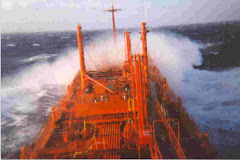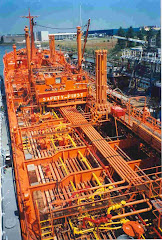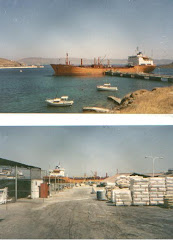Recently private equity group First Reserve bankrolled the Diamond S deal in which 30 product tankers were acquired from ship management company CIDO at a significant premium over prevailing market levels. This speculative spirit reminds me of the General Maritime block deal last year. Similar lust for quick profits of shipping in the early 1980’s led to ill-timed, mispriced major investment decisions and a series of major shipping bankruptcies, and period of severe market disruption. Will the Chinese Eldorado and Fed financial engineering save the day for Wall Street flip-over deals or are we at the end of the 1980’s economic cycle and age of asset inflation?
The major growth driver for cargo demand has been emerging market economies. This year started badly and all sectors are presently suffering. There has been lately some interest in containership and product tanker asset speculation. The only sector really making money is LNG where there is a healthy supply/ demand gap.
Despite the dicey economic environment, the shipping industry staged an unexpected recovery in 2009 and 2010. Dry Bulk benefitted heavily from Chinese stimulus infrastructure projects and commodities stockpiling. Tankers benefitted by oil price arbitraging and storage demand. The container sector managed to reflate demand artificially by slow steaming and then benefitted from a pick-up in Chinese exports.
There is nothing ‘miraculous’ or unique about the Chinese growth model. Well-known China observers like former Morgan Stanley star Andy Xie and political economist Victor Shih at Northwestern University have long maintained that the Chinese growth model is an input driven economy fuelled by cheap money through financial repression to increasingly marginal investments subject to diminishing returns.
Everybody is banking on opportunities of a giant boundless consumer market in China, but as Michael Pettis (senior associate in the Carnegie Asia Program, based in Beijing) has recently written: “Low consumption levels are not an accidental coincidence. They are fundamental to the growth model, and the suppression of consumption is a consequence of the very policies – low wage growth relative to productivity growth, an undervalued currency and, above all, artificially low interest rates – that have generated the furious GDP growth. You cannot change the former without giving up the latter.”
China funds almost all of its major investments with bank debt. It long ago ran out of obvious investments that are economically viable, so any marginal increases in investment must be matched by increases in debt, resulting in an unsustainable debt overhang. Meanwhile, with the US economy at stall speed and the EU imploding into recession, Chinese trade surpluses are no longer desirable with its trading partners.
Rebalancing is not an option for China and it is likely to be very disruptive and for a prolonged period of time. All historical precedents are for a sharp down downturn in economic growth. The decline in Chinese growth will fall disproportionately on investment and this will severely impact the price of non-food commodities.
A sharp Chinese slowdown will have a severe impact on cargo demand and freight rates. The drop in steel consumption from the infrastructure projects will adversely impact the economics of emerging market exporters of raw materials. Liquidity will start to dry up in all emerging market economies. Finally, decline in steel prices will adversely affected vessel values. Scrap prices will fall and replacement cost for new vessels will decline. Vessel prices could drop dramatically.
All shipping sectors will suffer. A recession in the EU and US will quash any increase in demand in the products markets. Emerging markets will not pick up the slack. The larger bulk carriers are very exposed with dependency on China and its steel industry. Container overcapacity will again plague the industry. Recent speculative Greek issues like Boxships and Diana containerships riding on hopes of increased demand for feeder services will fizzle as liner companies reduce their chartered fleet. The most painful aspect will be the drop in vessel values.
In such a scenario, it may take years before any recovery, totally changing speculative business plans and discounted cash flows where time is the biggest enemy to profitability. The nightmare of any short-term player is to be stuck with a losing proposition as a long-term investor. In many cases, the best option is to liquidate in timely fashion not to ride the market down to the bottom. That will be difficult with such a large positions. Maybe this is already being reflected in the recent pressure on shipping shares, even large well-capitalized tanker companies like OSG and TeeKay.
On the other hand, depressed market conditions would facilitate industry consolidation and clean-up of over-leveraged, deadwood companies with failed management. Since the 2008 meltdown, there is a growing list of zombie shipping companies swimming in debt and heavy consumers of lease financing at any cost. This would benefit the financially solid long term players and eventually give them better market pricing power. Lower vessel prices would make the industry leaner and more competitive.
Of course, nobody is a prophet. Next year, we could have a booming shipping markets, a new vessel ordering boom, and the Dow back over 12.000…. Imagine DryShips again trading over US$ 100 per share! George Economou has been a leading advocate of the Chinese unlimited growth story.
The major growth driver for cargo demand has been emerging market economies. This year started badly and all sectors are presently suffering. There has been lately some interest in containership and product tanker asset speculation. The only sector really making money is LNG where there is a healthy supply/ demand gap.
Despite the dicey economic environment, the shipping industry staged an unexpected recovery in 2009 and 2010. Dry Bulk benefitted heavily from Chinese stimulus infrastructure projects and commodities stockpiling. Tankers benefitted by oil price arbitraging and storage demand. The container sector managed to reflate demand artificially by slow steaming and then benefitted from a pick-up in Chinese exports.
There is nothing ‘miraculous’ or unique about the Chinese growth model. Well-known China observers like former Morgan Stanley star Andy Xie and political economist Victor Shih at Northwestern University have long maintained that the Chinese growth model is an input driven economy fuelled by cheap money through financial repression to increasingly marginal investments subject to diminishing returns.
Everybody is banking on opportunities of a giant boundless consumer market in China, but as Michael Pettis (senior associate in the Carnegie Asia Program, based in Beijing) has recently written: “Low consumption levels are not an accidental coincidence. They are fundamental to the growth model, and the suppression of consumption is a consequence of the very policies – low wage growth relative to productivity growth, an undervalued currency and, above all, artificially low interest rates – that have generated the furious GDP growth. You cannot change the former without giving up the latter.”
China funds almost all of its major investments with bank debt. It long ago ran out of obvious investments that are economically viable, so any marginal increases in investment must be matched by increases in debt, resulting in an unsustainable debt overhang. Meanwhile, with the US economy at stall speed and the EU imploding into recession, Chinese trade surpluses are no longer desirable with its trading partners.
Rebalancing is not an option for China and it is likely to be very disruptive and for a prolonged period of time. All historical precedents are for a sharp down downturn in economic growth. The decline in Chinese growth will fall disproportionately on investment and this will severely impact the price of non-food commodities.
A sharp Chinese slowdown will have a severe impact on cargo demand and freight rates. The drop in steel consumption from the infrastructure projects will adversely impact the economics of emerging market exporters of raw materials. Liquidity will start to dry up in all emerging market economies. Finally, decline in steel prices will adversely affected vessel values. Scrap prices will fall and replacement cost for new vessels will decline. Vessel prices could drop dramatically.
All shipping sectors will suffer. A recession in the EU and US will quash any increase in demand in the products markets. Emerging markets will not pick up the slack. The larger bulk carriers are very exposed with dependency on China and its steel industry. Container overcapacity will again plague the industry. Recent speculative Greek issues like Boxships and Diana containerships riding on hopes of increased demand for feeder services will fizzle as liner companies reduce their chartered fleet. The most painful aspect will be the drop in vessel values.
In such a scenario, it may take years before any recovery, totally changing speculative business plans and discounted cash flows where time is the biggest enemy to profitability. The nightmare of any short-term player is to be stuck with a losing proposition as a long-term investor. In many cases, the best option is to liquidate in timely fashion not to ride the market down to the bottom. That will be difficult with such a large positions. Maybe this is already being reflected in the recent pressure on shipping shares, even large well-capitalized tanker companies like OSG and TeeKay.
On the other hand, depressed market conditions would facilitate industry consolidation and clean-up of over-leveraged, deadwood companies with failed management. Since the 2008 meltdown, there is a growing list of zombie shipping companies swimming in debt and heavy consumers of lease financing at any cost. This would benefit the financially solid long term players and eventually give them better market pricing power. Lower vessel prices would make the industry leaner and more competitive.
Of course, nobody is a prophet. Next year, we could have a booming shipping markets, a new vessel ordering boom, and the Dow back over 12.000…. Imagine DryShips again trading over US$ 100 per share! George Economou has been a leading advocate of the Chinese unlimited growth story.








